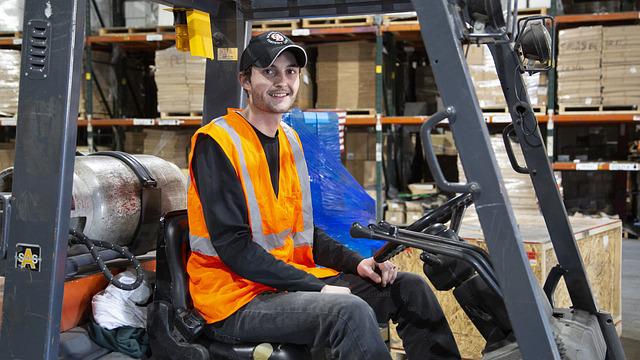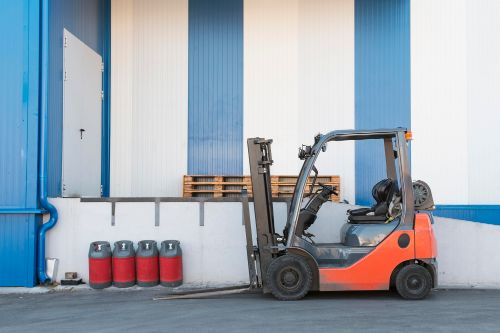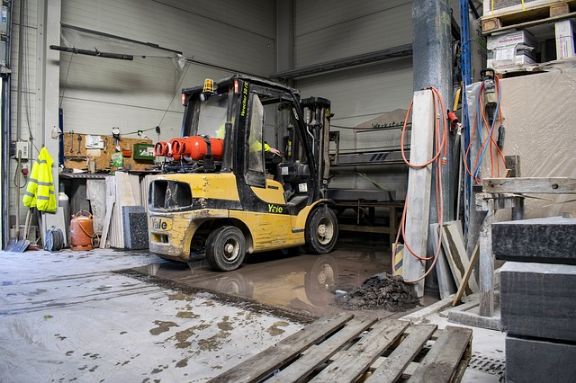
Most people don’t know that the pressure relief valve on a forklift propane tank should actually be pointing in the upward direction. This is something that is often overlooked, but it can actually be very important. The reason for this is that when the pressure relief valve is pointing downwards, it can actually allow for propane to leak out. This can be extremely dangerous, so it’s important to make sure that the valve is pointing in the right direction.
A propane tank pressure relief valve is a safety feature that is installed on all propane tanks. The valve is designed to release pressure from the tank if the pressure gets too high. The relief valve should always be pointing in the direction of the tank so that the pressure can be released safely.
Why Should the Pressure Relief Valve Point Upwards? Let’s Dive In!
The Science of Gases and Why They Like to Go Up
Ever noticed how smoke from a campfire or steam from a pot always goes up? The same idea applies here:
- Gases Want to Rise: When propane, the gas in your forklift’s tank, is released, it wants to shoot up. Why? Think of it like a balloon rising in the air. Propane, especially when let out, tends to be lighter than the air around it. By having the valve point upwards, you’re just letting it follow its natural path.
- Clearing Obstacles: Imagine you’re pouring water out of a jug. If you pour it directly onto a table, it’ll spread everywhere, right? Similarly, if propane is let out sideways or downwards, it might hit parts of your forklift or the ground, making it spread unpredictably. Pointing it up ensures it has a clear, obstacle-free path.
Now, Why Does This Matter for Safety?
Understanding the science is great, but let’s get to the main point: your safety.
- Avoiding Gas Puddles: Since propane is a bit heavier than air, if a lot of it gathers in one spot, especially near the ground, it’s like having a dangerous puddle of gas. And you don’t want that! By letting it out upwards, you make sure it doesn’t gather and create these risky gas puddles.
- Keeping Flames Away: If there’s a spark or flame around, a gas puddle can catch fire. That’s scary, right? When propane is released upwards, it spreads out and moves away quickly, so the chances of it catching fire are much lower.
- Breathing Easy: Propane isn’t something you want to breathe in. If it’s released upwards and away from you, it gets diluted in the air faster. This means less risk for you and those around you.
So, next time you look at a forklift’s propane tank, remember: that upward-pointing valve is a little guardian looking out for your safety, all thanks to some cool science!
Upward vs. Other Orientations
Understanding the position of a pressure relief valve on a forklift’s propane tank is crucial. But why exactly is the upward orientation favored? Let’s compare it to other possible directions.
Upward-Pointing Valves:
- Safety First: As we mentioned, propane wants to rise. With an upward-pointing valve, propane naturally disperses into the atmosphere, minimizing risks.
- No Obstacles: There’s a clear path for the gas to escape, ensuring no hindrances to its quick release.
Sideward-Pointing Valves:
- Potential Blockages: If you have the valve pointing sideways, there’s a good chance it might hit something – like parts of the forklift. This could cause the propane to bounce back or spread in unexpected ways.
- Closer to Ignition Sources: The sides of a forklift can have various components or moving parts. Any of these could potentially be a source of ignition, making sideward release risky.
Downward-Pointing Valves:
- Gas Pooling: Releasing propane downwards is like pouring water into a cup; it’s going to collect and pool. Pooling propane is dangerous because it creates pockets of concentrated gas that can ignite.
- Obstruction Risks: There’s more chance that debris or uneven ground might obstruct the valve, causing potential blockage or unpredictable gas flow.
Real-World Incidents Emphasizing the Importance of Upward Orientation:
- Warehouse Mishap: In a reported case, a forklift in a warehouse had a sideways pointing valve. A minor leak led to propane spreading along the ground and nearby shelving units. A small spark from a nearby electrical unit ignited the gas. Thankfully, no one was injured, but the incident highlighted the dangers of non-upward orientations.
- Outdoor Yard Incident: A forklift with a downward-pointing valve was parked on an uneven surface outdoors. A slight release of propane led to pooling in a hollow on the ground. An employee, unaware of the gas accumulation, started another vehicle nearby, causing a flash fire due to the ignition of the propane.
Both these incidents underscore the importance of the upward direction for pressure relief valves. While designs and safety measures continue to evolve, sticking to upward orientations, backed by real-world experiences, remains the safest bet for now.
Safety Implications of the Upward Direction
When it comes to handling propane, especially in forklift tanks, the upward direction of the pressure relief valve isn’t just by chance – it’s a critical safety feature. Here’s why:
- Minimizing the Risk of Propane Pooling at Ground Level:
- Think of propane like water for a moment. If you pour water out of a bottle onto flat ground, it will pool, right? Similarly, if propane is released and it doesn’t go up, it can pool at ground level. This is dangerous because propane is flammable, and a “pool” of gas can ignite if there’s a spark.
- Reducing Potential Fire Hazards:
- Propane is flammable. If it’s released close to the ground or in a direction where it can hit objects and not disperse quickly, you’re creating a potential fire zone. By releasing it upwards, you’re ensuring it moves away from common sources of ignition like electrical equipment or engine hotspots.
- Ensuring Quick Dispersion of Propane into the Atmosphere:
- If you let the propane go up, it mixes with the air and disperses more quickly. This means lower concentrations of gas around the forklift and thus a reduced risk of inhaling it or causing an explosion.
Performance and Efficiency Concerns
Beyond safety, the upward direction also has implications for the performance and efficiency of the propane tank and its associated systems:
- Ensuring Unobstructed Release of Excess Pressure:
- For a pressure relief valve to work effectively, the gas needs a clear path out. If the valve faces upwards, you’re giving the gas the best chance to escape without any hindrance. No parts of the forklift, no ground, just the open air above.
- Reducing the Potential for Clogs or Blockages:
- Debris, dust, or even ice (in cold conditions) can block a valve. If a valve is pointing downwards, it’s more exposed to these potential obstructions. An upward-pointing valve is less likely to get clogged, ensuring consistent performance.
In essence, pointing the pressure relief valve upward isn’t just a design preference. It’s an informed choice made for your safety and to ensure the forklift operates smoothly and efficiently.
Installation Best Practices
Installing a propane tank in a forklift isn’t just about connecting parts. Proper installation is key to safety and efficient operation. Let’s explore the right way to do it:
- Ensuring Correct Orientation During Tank Installations or Replacements:
- Marker Alignment: Ensure that alignment markers on the tank coincide with those on the forklift mount. These are there to guide you.
- Tight but Not Over-Tightened: Secure connections firmly, but avoid over-tightening, which can strain and damage the components.
- Common Mistakes and Misconceptions about Valve Positioning:
- “Any Direction Works”: Some believe that as long as the valve is accessible, its direction doesn’t matter. This isn’t true; orientation affects safety and efficiency.
- Using Tools to Force Positioning: Never use excessive force or tools to change the orientation of the valve. This could damage it.
Maintenance and Inspection
Maintenance isn’t a one-time thing. Regular checks and upkeep are vital to keep your forklift running safely:
- Regular Checks to Ensure the Valve Hasn’t Been Inadvertently Reoriented:
- Scheduled Inspections: Create a routine where the valve’s position is checked at regular intervals, especially after any maintenance work.
- Training: Ensure all staff are aware of the correct orientation and can spot if it’s amiss.
- Importance of Keeping the Valve Area Clear of Any Obstructions or Debris:
- Cleanliness: Ensure the area around the tank and valve is kept clean. Dirt, debris, or even ice can affect the valve’s performance.
- Protective Measures: Consider installing protective barriers or shields to prevent accidental hits or reorientations.
How much pressure is in the propane tank
This would depend on the temperature where the forklift truck is operating in. When operating in a normal 75 degrees, normally the pressure inside ranges between 135-145 psi. When the outside temperature rises the pressure also increases inside the tank.
In very hot weather, if the temperature reaches above 200 degrees of greater, which is considered very high, the valve will open to release some gas. Usually, 100-100 psi can be considered normal, and the valve won’t open.
The general rule of thumb is if the valve opens even at normal temperature, it is a sign of blockage or the device is defective. If the valve shows a decrease in pressure, there is a leak in the hose or fuel supply line.
The relief valve should point in the direction of the wind to avoid flame-outs
Forklift propane tank pressure relief valves are an important safety feature that helps to prevent the tank from exploding in the event of a fire. The valve should be located in the direction of the prevailing wind to ensure that the flames from the tank are blown away from the operator and other nearby workers.
The pressure relief valve should be set to the correctly
A pressure relief valve is a device that helps to regulate the propane gas in the tank. By keeping the pressure at a safe level, the valve helps to prevent the tank from exploding. Internal regulator works to limit the flow of propane into the engine.
The relief valve should be set to the correct pressure before using the forklift. If the pressure in the tank gets very excessive, the valve will release propane gas to relieve the pressure.
Overfilling can result to some issues such as in this video
The valve should be inspected regularly
Forklift propane tank pressure relief valves (PRVs) are a critical safety component, and as such, should be regularly inspected. PRVs are designed to relieve pressure build-up inside a propane tank, and if they are not functioning properly, can lead to dangerous situations.
There are two main types of PRVs: spring-loaded and diaphragm-operated. Spring-loaded PRVs are the most common and consist of a spring-loaded valve that opens when the pressure inside the tank reaches a certain level. Diaphragm-operated PRVs are less common but are often used on larger tanks. These valves use a diaphragm to open and close the valve and are more sensitive to pressure changes.
PRVs should be inspected at least once per year, and more often if they are used frequently. During an inspection, the valve should be checked for proper operation, and the spring tension should be checked on spring-loaded valves. All PRVs should be replaced if they are not functioning properly.
The device should not be blocked
This is a safety device that is designed to release pressure from the tank if it gets too excessive. If the valve becomes blocked, it can prevent the release of pressure, which can cause the tank to explode. Always make sure that the valve is clear and unobstructed so that it can do its job.
The relief valve should not be rusted and be kept in good condition
The device should not be rusted. A relief valve is a safety device that is installed on a propane tank to prevent over-pressurization of the tank. The valve is opened by the pressure of the propane gas inside the tank, and allows the gas to vent to the atmosphere. This prevents the tank from exploding.
The valve must be able to open and close properly in order to work correctly. If the valve is stuck in the open position, the propane will continually vent from the tank and the tank will eventually be empty. If the valve is stuck in the closed position, the propane gas will build up in the tank and could cause the tank to explode.
The relief valve on a forklift propane tank is a safety feature that is designed to release pressure if the tank gets too hot. This can prevent the tank from exploding and causing serious damage or injury. The valve should be checked regularly to make sure it is in good condition and working properly. If the valve is damaged or not working properly, it should be replaced.
Proper installation of the device is important
The valve is designed to release pressure from the tank if the pressure inside the tank becomes too excessive. This can happen if the temperature of the propane inside the tank rises too high. The pressure relief valve will open and release some of the propane from the tank to relieve the propane gas. The valve is usually located at the top of the tank.
The device must be properly installed in order for it to work properly. The valve must be pointing straight up so that when it opens, the propane will be released in a safe direction. The valve must also be the correct size for the tank. If the valve is too small, it may not be able to release all the gas from the tank. If the valve is too large, it may release too much propane from the tank.
It is important to have a relief valve installed on your forklift propane tank. The valve can help to prevent the tank from exploding if the gas pressure inside the tank rises above the limit. To know related OSHA requirements, see this page.
Follow the manufacturer’s instructions
The forklift propane tank pressure relief valve should be used in accordance with the manufacturer’s instructions. The pressure can build up inside the tank. This can happen if the tank is exposed to heat or if there is a blockage in the tank that prevents the propane from flowing out. If the pressure relief valve is not used properly, it can cause the tank to explode.
The relief valve should be checked for leaks
The relief valve on a forklift propane tank should be checked regularly for leaks. This is because the valve is responsible for releasing of the gas from the tank in the event of a build-up. If the valve is not working properly, it could lead to an explosion.
To check the device, first make sure that the tank is turned off and cool. Then, open the valve and listen for any hissing or leaking sounds. If you hear anything, that means there is a leak and the valve needs to be replaced.
It’s important to check the relief valve on your forklift propane tank because a leak can be very dangerous. If the valve is not working properly, it could lead to an explosion. So, be sure to check it regularly and replace it if necessary.
Conclusion
Proper valve orientation on a forklift’s propane tank isn’t just a technical specification; it’s a crucial component of ensuring safety and top-tier performance. Just as you wouldn’t drive a car with misaligned wheels, operating a forklift without ensuring the right valve positioning can have unforeseen consequences.
The science and real-world incidents have demonstrated the risks associated with getting it wrong. Beyond just the immediate dangers, there are implications for operational efficiency, regulatory compliance, and even potential legal liabilities.
But it’s not all cautionary tales. With regular checks, adherence to best practices, and a commitment to staying informed, these risks can be minimized.
Take Action Now: Don’t wait for an incident to underline the importance of correct valve orientation. Make it a point to regularly inspect your equipment, ensure proper installations, and keep your team trained and informed. After all, in the world of machinery, a small check today can prevent a significant problem tomorrow. Safety and efficiency go hand-in-hand, and it begins with getting the basics right.

Mike is an experienced propane technician with over 15 years of professional experience in the field. He has dedicated his career to helping customers with their propane needs, from installation to maintenance and repair. Together with Jeremy, he co-founded this website to provide useful information and guidance to customers seeking reliable propane services.




